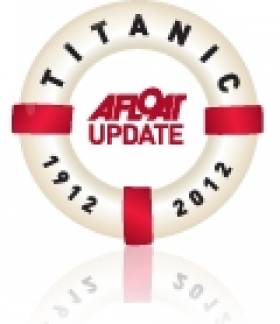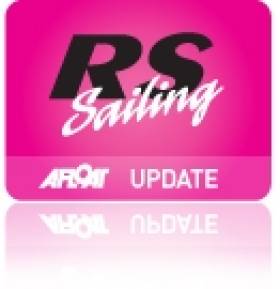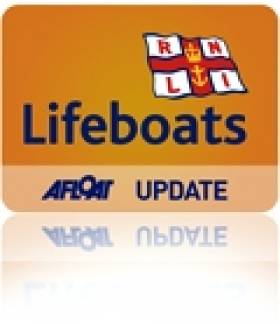Displaying items by tag: Belfast Lough
Byford Dolphin Oil Rig Arrives In Belfast For Refit
#ByfordDolphin - Oil rig Byford Dolphin finally arrived in Belfast for her refit at the weekend, spelling a significant jobs boost for the city's port.
As previously reported on Afloat.ie, the contract to dry-dock and survey the rig – sister to the Blackford Dolphin that the city hosted last year – was announced earlier this month.
Formerly a visitor to Belfast Lough herself for repairs back in 2004, the Byford Dolphin could provide for as many as 1,000 jobs at the Harland & Wolff shipyard, according to the News Letter – which has more on the story HERE.
Photo Collection Documents Launch Of The Titanic
#Titanic - The year won't be complete without sharing this wonderful collection of images from the launch of the RMS Titanic at Belfast Lough in 1911, courtesy of the Belfast Telegraph.
The stunning photographs were taken by John W Kempster, a senior engineer at the Harland and Wolff shipyards, as the ill-fated vessel was moved from her slipway into the lough.
And they were never seen in public before their unveiling in October at the Ulster Folk and Transport Museum, where they will remain on display till next summer.
Apart from the Titanic, the photo collection also documents the construction of her sister ship the Olympic, on which Kempster and his family sailed to America on her maiden voyage.
The Belfast Telegraph has much more on the story HERE.
Belfast Lough Sailability Hails Community Fundraising
#BelfastLough - Antrim-based charity Belfast Lough Sailability has underscored the importance of community fundraising to its cause, as the Carrick Times reports.
The training organisation for sailors with disabilities, which is currently seeking more volunteers to assist in its teaching efforts, was one of a number of charities celebrating 25 years of the grant partnership between BT, the Communication Workers' Union and the Community Foundation for Northern Ireland.
Belfast Lough Sailability (BLS) chair Anne Taylor said the grant scheme, that has awarded over £1 million to community groups over the years, aided funding of specialised training for its own instructors.
BLS is now looking into an even more ambitious project - a purpose-built home base at Carrickfergus Marina on Belfast Lough that would enable the charity to expand its remit across Northern Ireland.
The Carrick Times has more on this story HERE.
Belfast Lough Sailability Seeks More Volunteers For Training
#BelfastLough - Belfast Lough Sailability is on the lookout for new volunteers to assist in its sail training efforts for people with disabilities.
As highlighted in the Carrick Times recently, the Northern Irish charity regularly runs training sessions from its base at Carrickfergus Marina on Belfast Lough, making use of its fleet of specially adapted boats.
But the practical training - provided by a team of qualified instructors as well as a number of disabled sailors - also involves skills useful off the water, such as first aid.
The Carrick Times has more on the story HERE.
Views Over Belfast Lough From Holywood Four-Bed Family Home
#WaterfrontProperty - A spacious detached four-bed family home with views across Belfast Lough could be yours for less than €900,000.
The News Letter has all the details on 9 Whinney Hill at Holywood in Co Down, a modernised and renovated home with a bounty of four reception rooms on the ground floor.
Two of these open via french doors onto a large decking area with views of the Antrim Hills across the lough.
Other features include central gas coal fires in the dining room and adjoining living room, a jacuzzi-style bath in the master bedroom en-suite, and plenty of space for multiple cars to park out front.
The News Letters has much more on this property HERE.
Want to Set Sail on a Tall Ship in 2015?
Belfast Tall Ships is offering 80 people from Northern Ireland the chance to become trainee crew members as part of celebratinos next July when tall ships from across the globe will anchor in Belfast for the start of The Lidl sponsored Belfast Titanic Maritime Festival, Belfast's biggest ever event.
The vessels will dock in Belfast from 2 July before departing on 5 July, for Ålesund in Norway. You can view the full route map on the Sail Training International website.
Belfast Tall Ships is offering the places on a ten-day voyage.
This unique opportunity is open to all ages and anyone can take part in a voyage. Contact the festival organisers for more information or send your details to Sail Training Ireland
Imagine the sense of accomplishment when you arrive in Ålesund having sailed 690 miles across the North Sea! Once there, you'll have a few days to celebrate your achievement with other crew and participate in the local social activities before returning home to Belfast.
Anyone can sail and no experience is necessary as some training will be provided.
You can watch a short video to see what it's like to be a crew trainee.
To register your expression of interest go to here
RS400s Take to Belfast Lough for Royal North Series
#rssailing – 13 RS 400s came to the Royal North of Ireland line yesterday, with boats coming from Cushendall, Dublin and Ballyholme. The RNIYC series runs for another six weeks, breaking for Christmas, then starting again for 12 weeks as the 'Frosties'.
NATO Minehunters To Make Bold Display In Belfast Lough
#BelfastLough - A fleet of eight NATO minehunters is set to make a bold display in Belfast Lough tomorrow morning (Friday 17 October).
As the Ballymena Times reports, the ships and their international crews - part of the Standing NATO Mine Counter-Measures Group - will be in Belfast till next Tuesday as part of an exercise led by the Royal Navy.
Though they won't be open to the general public, it's still a great opportunity to see so many military vessels in one setting.
Bangor Lifeboat Rescues Two On Stricken Trimaran In Belfast Lough
#RNLI - At 5.25pm yesterday evening (Tuesday 30 September) the Bangor RNLI volunteer lifeboat crew received a request from Belfast Coastguard to assist two people onboard a 28ft trimaran-type yacht.
The multihull vessel, consisting of a main hull and two out-rigging hulls, had experienced engine failure two nautical miles north of Black Head on northern shores of Belfast Lough.
Within minutes of the rescue pagers being activated, the volunteer crew had launched the lifeboat, which proceeded at full speed towards the stricken vessel.
Upon arrival, the crew found that the two people on board the yacht were experienced yachtsmen. They had followed procedure and made the correct decision to call for assistance at the first sign of trouble.
With weather conditions on scene deteriorating, and a moderate to rough sea state, one of the lifeboat crew was transferred to the yacht to assist in rigging a tow line.
The vessel was then taken under tow and after two-and-a-half hours arrived safely at Bangor Marina.
RNLI volunteer helmsman Connor Lawson used this rescue to highlight a RNLI safety message when he said: "We always urge everyone going afloat to make sure their engine and fuel systems and are well maintained and in good working order.
"Engine failure close to shore and commercial shipping routes could lead to a life threatening situation."
He added: "We're happy that everyone is now safely ashore."
NI Minister Greenlights Belfast Harbour Expansion
#BelfastHarbour - 4NI reports that Northern Ireland Environment Minister Mark Durkan has granted planning permission for a 60-acre extension to Belfast Harbour.
The expansion for port-related uses goes hand in hand with last year's announcement of Ireland's first dedicated cruise terminal for Belfast Harbour, that would accommodate next-generation cruise liners carrying more than 4,500 passengers and crew.
Minister Durkan said the expansion plans were "good news for Belfast" in terms of both enhancing the port and providing construction jobs.







































































